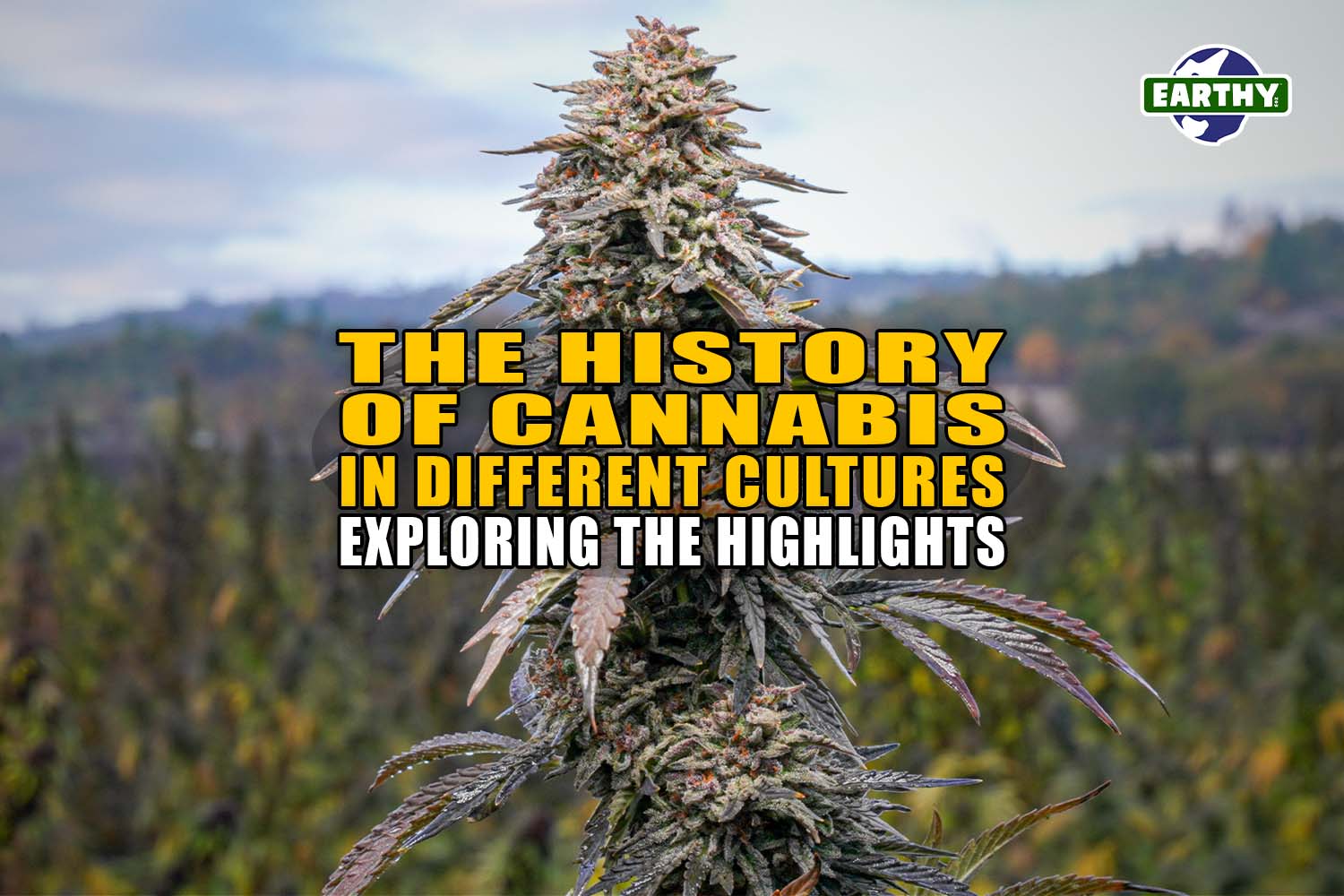Cannabis, a plant with a rich and varied history, has played a significant role in many cultures. Indeed, the history of cannabis intertwines with human civilization, reflecting the diverse ways in which societies have utilized the plant for medical, spiritual, and industrial purposes. From ancient rituals to modern medical cannabis research, the cannabis plant has had a profound impact on human history.
Early human use of the potent, flowering plants
Ancient China
Cannabis use in ancient China dates back to at least 2700 BCE, with the hemp plant being a vital part of traditional Chinese medicine. For example, the Chinese recognized medicinal use of cannabis for treating various ailments, including pain relief and digestive disorders. Additionally, the inhabitants of ancient Chinese culture utilized the plant’s psychoactive properties. However, they primarily used the plant for medicinal rather than recreational purposes [1].
Ancient India
In ancient India, the use of cannabis, known as bhang, played a crucial role in spiritual and religious practices. The Atharva Veda, a sacred Hindu text, mentions cannabis as one of the five sacred plants. Also, they used cannabis in Ayurvedic medicine for purported therapeutic properties, addressing conditions such as insomnia, headaches, and gastrointestinal issues [2].
Ancient Egypt
The ancient Egyptians also used cannabis for medicinal properties, as evidenced by references in medical papyri. For example, texts reveal they used cannabis resin for inflammation and glaucoma. They were also aware of the plant’s psychoactive effects, although, like China, its primary use remained medicinal [3].
Mesopotamia
Ancient Mesopotamians used cannabis in rituals and medicine. For instance, historical records suggest that the Sumerians and Assyrians were familiar with the cannabis plant, incorporating it into their religious ceremonies and healing practices. More specifically, clay tablets indicate that they used it as a remedy for grief and epilepsy [4]. Fast forward to the modern CBD-based pharmaceutical Epidiolex for epilepsy [5].
Cannabis in the Middle East and Islamic culture
Early Islamic period
Cannabis use in the Middle East during the early Islamic period was complex, with varying attitudes towards its consumption. For example, while some Islamic scholars condemned its use, others recognized medicinal and psychoactive properties. Overall, cannabis was widely cultivated and used for both medicinal and religious purposes [6].
Other Semitic cultures of the Middle East, including the Egyptians and Hebrews, burned it as incense as early as 1000 BC. Notably, these early Middle Easterners likely used cannabis oil for centuries before and after the birth of Jesus [7].
Sufi tradition
The Sufi tradition within Islam embraced the use of cannabis for spiritual enlightenment. For instance, Sufi mystics believed that the plant could help them achieve a higher state of consciousness. Despite periodic prohibitions, cannabis remained an integral part of Sufi rituals [8].
Cannabis in Africa
Ancient and indigenous uses
Cannabis has a long history in Africa, particularly in North Africa, where inhabitants used it in traditional medicine and rituals. Indeed, the hemp plant was an important crop, valued for its flower, fibers, and seeds. Indigenous tribes also enjoyed its psychoactive effects [9].
Colonial era
The colonial era brought significant changes to cannabis use in Africa. For example, European colonizers introduced new regulations and perceptions, often viewing cannabis as a narcotic drug associated with drug abuse. Ultimately, these attitudes led to stricter controls and a decline in traditional uses [9].
Cannabis in Europe
Ancient Greece and Rome
Ancient Greeks and Romans used cannabis for medicinal and industrial applications. For example, Greek physicians, such as the renowned Dioscorides, documented observed therapeutic properties in ancient texts. Also, the Romans cultivated cannabis for fiber, essential for making ropes and sails [10].
Medieval Europe
During the medieval period, knowledge and use of cannabis declined in Europe. In particular, the influence of the church and evolving legal restrictions contributed to this decline. Despite this, some medicinal uses persisted. However, hemp continued to be widely used to make rope and cloth [11].
Renaissance and Enlightenment eras
The Renaissance and Enlightenment periods saw a revival of interest in cannabis. For example, European explorers and botanists, intrigued by the plant’s psychoactive compound, conducted cannabis research to understand its effects and potential medical uses [12].
Cannabis in the Americas
Colonial and post-colonial periods
Cannabis was introduced to the Americas by European settlers, including the Spaniards, who imported hemp seeds for cultivation. Over time, cannabis use evolved, with shifts in legal status and cultural attitudes. By the 20th century, cannabis became associated with recreational use, leading to the Marijuana Tax Act of 1937 in the United States, which heavily restricted its use [12].
Modern era and globalization
19th and early 20th century
The 19th and early 20th centuries saw the spread of cannabis through global trade. Notably, scientists studied cannabis strains for their medical and recreational potential. However, increasing concerns over drug abuse and its negative effects led to tighter controls and prohibitions [12].
Mid to late 20th century
The mid to late 20th century was marked by significant changes in cannabis policy. For example, the rise of counterculture movements in the 1960s and 1970s challenged the prevailing negative perceptions of cannabis. Despite federal laws criminalizing cannabis, such as the Controlled Substances Act, movements advocating for legalized marijuana gained momentum [12].
21st century
The 21st century has seen a dramatic shift in the global perspective on cannabis. For instance, legalization efforts for both medical and recreational cannabis have gained traction in many countries. Notably, the Compassionate Use Act of 1996 in California marked the beginning of modern medical cannabis legislation in the United States. Since then, cannabis research has expanded, focusing on the plant’s wellness properties and psychoactive effects [13]. Moreover, studies on cannabinoids, cannabinoid receptors, and cannabinoid variation have provided deeper insights into how cannabis can benefit various conditions, including appetite stimulation for chemotherapy and AIDS patients [14].
The Role of Cannabis in Modern Medicine
Recent years
Over recent decades, the modern cannabis scene in the United States has undergone a radical transformation. With changing federal laws, increased cannabis cultivation, and a growing acceptance of both medical and recreational use, cannabis remains a prominent feature in American society. Notably, this shift has influenced global perspectives as other countries in the Western Hemisphere and beyond reevaluate their cannabis policies [15]. Let’s take a closer look at key aspects of the modern cannabis landscape in the US.
A Brief Legal History of Hemp Prohibition
Key aspects of the modern cannabis scene
- Legalization trends have led to a thriving industry, with advances in cannabis cultivation, optimizing the growth of high-quality flowering buds [16].
- Despite state-level legalization in the US, marijuana remains classified as a Schedule I narcotic drug under federal law, creating a complex legal environment for businesses and consumers [17].
- Smoking remains one of the most popular methods of consumption, although alternatives like edibles and vaporizers have gained traction. However, health professionals warn that the impact of cannabis smoke may have similar health repercussions to that of tobacco smoking [18].
- Cannabis seeds have become a booming industry, with growers seeking specific strains for desired effects and higher average THC content [19].
- The United Nations Office on Drugs and Crime and the World Drug Report frequently assesses the global status of cannabis use and its implications, reflecting shifting international perspectives [20].
- Many patients enjoy the medical use of cannabis as an alternative to traditional prescription drugs.
- Marijuana is classified alongside other psychotropic substances, recognized for its psychoactive effects due to THC.
- The cultivation of industrial hemp, which has low THC content, has been legalized federally [21].
Top 20 Cannabis Derived Terpenes
Premium Cannabis products from Earthy Now
For cannabis consumers seeking reliable, trustworthy sources of cannabis flower and other hemp-derived products, Earthy Now has something for everyone. These products reflect the industry’s cleanest and strongest, with only trace amounts of Delta-9 THC.
Explore these natural, organic products from Earthy Now, delivered discreetly to your door:
- CBD Flower
- Gummies
- Lozenges
- Tablets (THC Free!)
- Soothing Relief Lotion
- Soothing Relief Salve
- CBD Pet Tinctures (no THC!)
- Oils
- Pre-Rolls
- Smokes
- Terpenes
Cannabis Cigarettes vs Traditional Smoking
Key takeaway: history of cannabis in different cultures
The cultural history of cannabis is a testament to its enduring significance across different societies. From its earliest use in ancient civilizations to its modern role in medicine and recreation, cannabis has been an important crop with diverse applications. As cannabis research continues to uncover new uses, the future of cannabis holds promising possibilities. Understanding the history of cannabis helps us appreciate its multifaceted role in human culture and its potential for future benefits.
Visit Earthy Now and peruse a wide menu of popular cannabis products for well-being!
Medical Disclaimer / Legal Disclaimer – Information is provided for educational purposes. It does not and is not intended to constitute legal advice or medical advice. We attempt to be accurate and up-to-date, but the legality of cannabinoids and the science of cannabis are evolving. The author is neither a legal professional nor a medical expert. Before buying or using any products, you should check with your local authorities and medical providers.
References
- The History of the Cannabis Plant
- In Remote Northern India, Weed Isn’t a Trend—It’s a Way of Life
- History of Medical Cannabis
- Cannabis – Miracle Medicine or Psychosis-Inducing Drug?
- Pioneering CBD For Epilepsy Treatment And Prevention
- When Hashish and Islam Went Hand in Hand (and Was Used to Connect with God)
- Cannabis and Religion
- Cannabis Traditions in Sufi Mysticism
- An African History of Cannabis
- Cannabis in Ancient Greece and Rome
- Marijuana – The First Twelve Thousand Years
- A Brief Global History of the War on Cannabis
- Then vs. Now: The History of Medical Marijuana
- Medical Cannabis Use in Oncology
- Marijuana Legalization: What Can Be Learned From Other Countries
- Cannabis Production Trends and Innovations
- Cannabis Facts
- Cannabis and Lung Health
- Seeds for High THC Cannabis Strains
- Booklet 3 – Drug Market Trends of Cannabis and Opioids
- Hemp Industry 2024: State and Federal Changes





 Earthy Now
Earthy Now